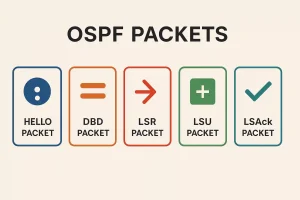Master OSPF Packets Type: Essential Knowledge for Cisco Certification (Updated 2025)
Open Shortest Path First (OSPF) is a powerful link-state routing protocol widely used in enterprise networks and a key topic for CCNA and CCNP certifications. OSPF relies on five distinct packet types to establish neighbor adjacencies, exchange routing information, and maintain a consistent Link-State Database (LSDB) across routers in an area. Understanding these OSPF packets—Hello, […]

